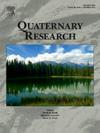氯和宇宙成因 36Cl 与岩浆碳酸盐的结合
IF 1.8
3区 地球科学
Q3 GEOGRAPHY, PHYSICAL
引用次数: 0
摘要
洞穴碳酸盐矿床(洞穴主题)含有微量元素,它们作为古气候和环境指标的重要性得到了深入的研究。然而,在海洋和大气水体中含量丰富的氯作为潜在的古辐射代用物一直被忽视,而宇宙起源的36Cl原则上可以提供太阳辐照度代用物。在这里,从各种洞穴中分析的总氯浓度很低(3-14毫克/公斤),与晶体结构有关。高分辨率同步辐射微x射线荧光(μ-XRF)微量元素映射显示Cl通常与Na, Si和Al相关。我们认为洞穴中含有Cl的两个部分:(1)水溶性(如流体包裹体)和(2)水不溶性和强结合(如与碎屑颗粒相关)。然而,差异表明Cl掺入的其他未确定机制存在,提出了许多微量元素掺入洞穴的重要问题。由于Cl浓度低,我们首次测量洞穴中36Cl/Cl的比例需要大量样本,这限制了36Cl作为太阳辐照度代理的潜力。重要的是,我们的发现强调了Cl和其他微量元素是如何被纳入洞穴的,这些元素的结合机制和最终元素浓度如何与洞穴结构相关,以及这对如何将洞穴中的微量元素解释为古气候代用物可能具有的意义。本文章由计算机程序翻译,如有差异,请以英文原文为准。
The incorporation of chlorine and cosmogenic 36Cl into speleothem carbonate
Cave carbonate mineral deposits (speleothems) contain trace elements that are intensively investigated for their significance as palaeoclimate and environmental proxies. However, chlorine, which is abundant in marine and meteoric waters, has been overlooked as a potential palaeo-proxy, while cosmogenic 36 Cl could, in principle, provide a solar irradiance proxy. Here, total Cl concentrations analysed from various speleothems were low (3–14 mg/kg), with variations linked to crystal fabrics. High-resolution synchrotron radiation micro X-ray fluorescence (μ-XRF) trace element mapping showed Cl often associated with Na, Si, and Al. We propose that speleothems incorporate Cl in two fractions: (1) water soluble (e.g., fluid inclusions) and (2) water insoluble and strongly bound (e.g., associated with detrital particulates). However, disparities indicated that alternate unidentified mechanisms for Cl incorporation were present, raising important questions regarding incorporation of many trace elements into speleothems. Our first measurements of 36 Cl/Cl ratios in speleothems required large samples due to low Cl concentrations, limiting the potential of 36 Cl as a solar irradiance proxy. Critically, our findings highlight a knowledge gap into how Cl and other trace elements are incorporated into speleothems, how the incorporation mechanisms and final elemental concentrations are related to speleothem fabrics, and the significance this may have for how trace elements in speleothems are interpreted as palaeoclimate proxies.
求助全文
通过发布文献求助,成功后即可免费获取论文全文。
去求助
来源期刊

Quaternary Research
地学-地球科学综合
CiteScore
4.70
自引率
8.70%
发文量
57
审稿时长
3 months
期刊介绍:
Quaternary Research is an international journal devoted to the advancement of the interdisciplinary understanding of the Quaternary Period. We aim to publish articles of broad interest with relevance to more than one discipline, and that constitute a significant new contribution to Quaternary science. The journal’s scope is global, building on its nearly 50-year history in advancing the understanding of earth and human history through interdisciplinary study of the last 2.6 million years.
 求助内容:
求助内容: 应助结果提醒方式:
应助结果提醒方式:


